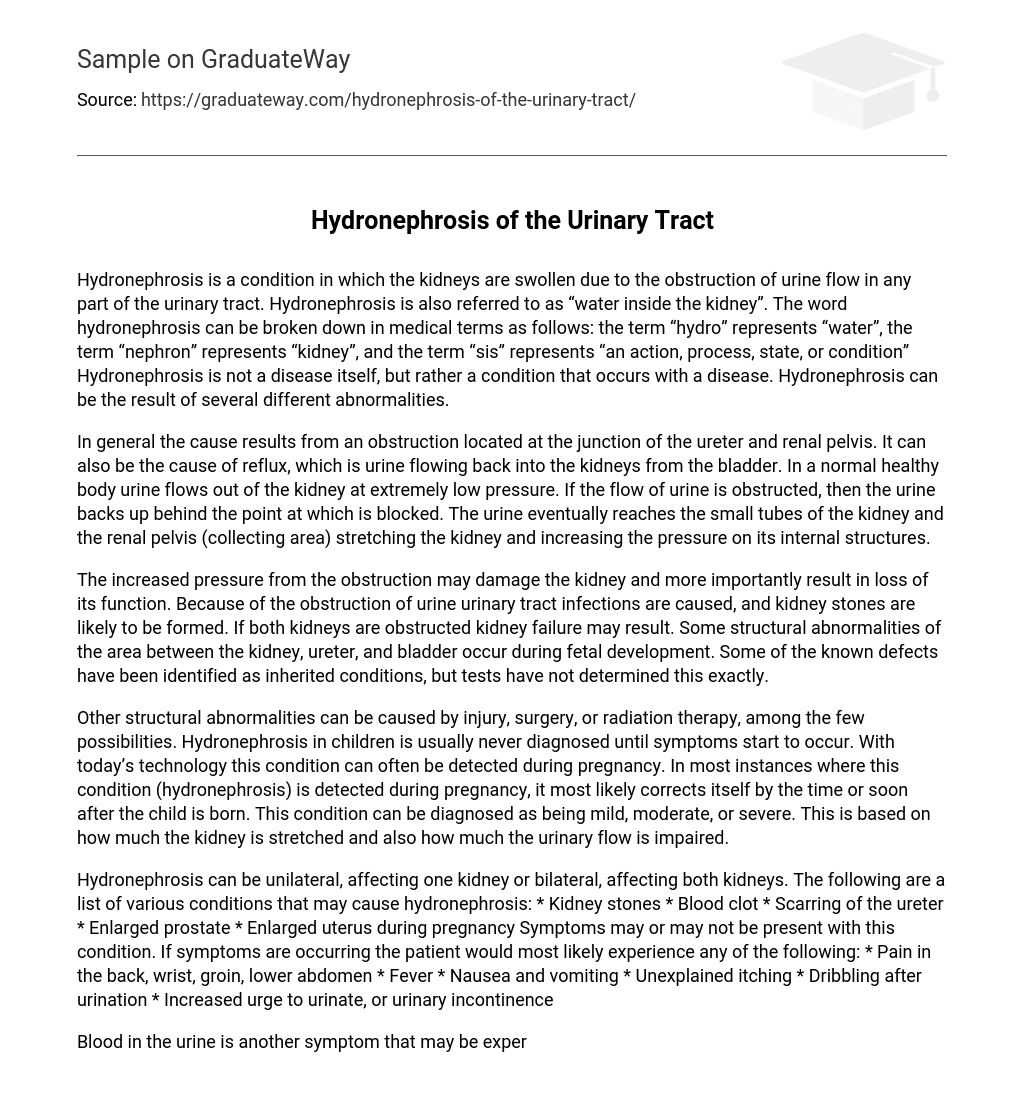Hydronephrosis, also referred to as “water inside the kidney,” happens due to a urinary tract blockage that results in kidney swelling. The term “hydronephrosis” is a combination of the words “hydro” (meaning “water”), “nephron” (meaning “kidney”), and “sis” (indicating an action, process, state, or condition). It is not an independent illness but instead accompanies other diseases. Hydronephrosis can occur due to different abnormalities.
The condition typically occurs when an obstruction occurs at the junction of the ureter and renal pelvis, leading to a backflow of urine into the kidneys from the bladder (known as reflux). Ordinarily, urine flows out of the kidney with minimal pressure. However, if there is an obstruction in urine flow, it will build up behind the blockage. Eventually, this accumulated urine reaches the small tubes and collecting area of the kidney, causing it to stretch and exert increased pressure on its internal structures.
Obstruction in the urinary system can lead to several complications, including kidney damage, loss of kidney function, urinary tract infections, and kidney stone formation. If both kidneys are obstructed, it may ultimately result in kidney failure. Certain structural abnormalities in the region connecting the kidney, ureter, and bladder could potentially develop during fetal development and be inherited; however, this has not been definitively confirmed through tests.
Structural abnormalities may occur due to injury, surgery, or radiation therapy. In children, the diagnosis of hydronephrosis typically occurs when symptoms manifest. Nevertheless, advancements in technology have made it possible to detect this condition during pregnancy. If identified before or shortly after birth, hydronephrosis often resolves spontaneously. The severity of the condition depends on the extent of kidney stretching and presence of urinary flow obstruction.
Hydronephrosis can affect one kidney (unilateral) or both kidneys (bilateral), and it can be caused by various conditions. These conditions include kidney stones, blood clots, scarring of the ureter, enlarged prostate, or enlarged uterus during pregnancy. Symptoms may vary and can include pain in the back, wrist, groin, or lower abdomen; fever; nausea and vomiting; unexplained itching; dribbling after urination; increased urge to urinate; or urinary incontinence.
Not ignoring blood in the urine is crucial because it is not a common symptom. If someone has this symptom, they should quickly contact their healthcare provider. Diagnosing hydronephrosis can be easy, especially when detected before birth in children. However, there are cases where diagnosing may be more difficult and only become apparent when evaluating a patient with weakness symptoms. Routine ultrasounds during pregnancy often identify hydronephrosis in pediatric cases.
The process of diagnosing hydronephrosis typically begins by questioning the patient about their signs and symptoms. Depending on the information obtained, additional tests may be required. The patient’s medical history and family history can help in determining this condition. Various laboratory tests such as urinalysis, complete blood count, electrolyte analysis, and blood urea nitrogen (BUN) test can be conducted to diagnose hydronephrosis. After confirming the diagnosis, treatment is the subsequent step.
Treating hydronephrosis involves eliminating the obstruction and restoring normal urine flow from the kidney. Options for treatment include inserting a catheter to bypass a constricted prostate or surgically removing a cancerous bladder and reconstructing it using part of the bowel in complex cases. If there is considerable kidney damage, removal of the kidney may be necessary. Initially, the focus is on alleviating pain and preventing urinary tract infections. Fortunately, healthcare providers usually achieve positive outcomes with their chosen treatment method.
Complications can arise from hydronephrosis and should be taken into account. Neglecting to address this condition may result in a rise in kidney pressure, leading to diminished blood filtration, waste elimination, urine production, and electrolyte regulation. Regrettably, there is no particular method to preempt this condition as it stems from an underlying abnormality. Prevention relies on evading the root cause. For example, people with kidney stones can strive to lower their chances of acquiring more stones by maintaining proper hydration.





